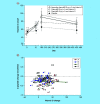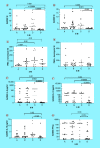Combined vitamin D, ibuprofen and glutamic acid decarboxylase-alum treatment in recent onset Type I diabetes: lessons from the DIABGAD randomized pilot trial
- PMID: 32802401
- PMCID: PMC7421935
- DOI: 10.2144/fsoa-2020-0078
Combined vitamin D, ibuprofen and glutamic acid decarboxylase-alum treatment in recent onset Type I diabetes: lessons from the DIABGAD randomized pilot trial
Abstract
Aim: Double-blind placebo-controlled intervention using glutamic acid decarboxylase (GAD)-alum, vitamin D and Ibuprofen in recent onset Type I diabetes (T1D).
Methods: 64 patients (T1D since <4 months, age 10-17.99, fasting sC-peptide ≥0.12 nmol/l, GADA-positive) were randomized into Day(D) 1-90 400 mg/day Ibuprofen, D1-450 vitamin D 2000 IU/day, D15, 45 sc. 20 μg GAD-alum; as A but placebo instead of Ibuprofen; as B but 40 μg GAD-alum D15, 45; placebo.
Results: Treatment was safe and tolerable. No C-peptide preservation was observed. We observed a linear correlation of baseline C-peptide, HbA1c and insulin/per kilogram/24 h with change in C-peptide AUC at 15 months (r = -0.776, p < 0.0001).
Conclusion: Ibuprofen, vitamin D + GAD-alum did not preserve C-peptide. Treatment efficacy was influenced by baseline clinical and immunological factors and vitamin D concentration. Clinical Trial Registration: NCT01785108 (ClinicalTrials.gov).
Keywords: C-peptide; GAD-alum; Type I diabetes; ibuprofen; immune response; vitamin D.
© 2020 Johnny Ludvigsson.
Conflict of interest statement
Financial & competing interests disclosure This trial was generously funded by Barndiabetesfonden (Swedish Child Diabetes Foundation), FORSS (the Research Council of Southeast Sweden), ALF (Region Östergötland) and unrestricted grants from Diamyd Medical. The funders had no role in designing or performing the study, nor in interpreting or presenting the results. The authors have no other relevant affiliations or financial involvement with any organization or entity with a financial interest in or financial conflict with the subject matter or materials discussed in the manuscript apart from those disclosed. No writing assistance was utilized in the production of this manuscript.
Figures





References
-
- Bojestig M, Arnqvist HJ, Hermansson G. et al. Declining incidence of nephropathy in insulin-dependent diabetes mellitus. N. Engl. J. Med. 330, 15–18 (1994). - PubMed
-
- Lind M, Svensson AM, Rosengren A. Glycemic control and excess mortality in Type I diabetes. N. Engl. J. Med. 372(9), 880–881 (2015). - PubMed
-
- Steffes MW, Sibley S, Jackson M, Thomas W. Beta-cell function and the development of diabetes-related complications in the diabetes control and complications trial. Diabetes Care 26, 832–836 (2003). - PubMed
-
- Stiller CR, Laupacis A, Dupre J. et al. Cyclosporine for treatment of early Type I diabetes: preliminary results. N. Engl. J. Med. 308(20), 1226–1227 (1983). - PubMed
Associated data
LinkOut - more resources
Full Text Sources
Medical
